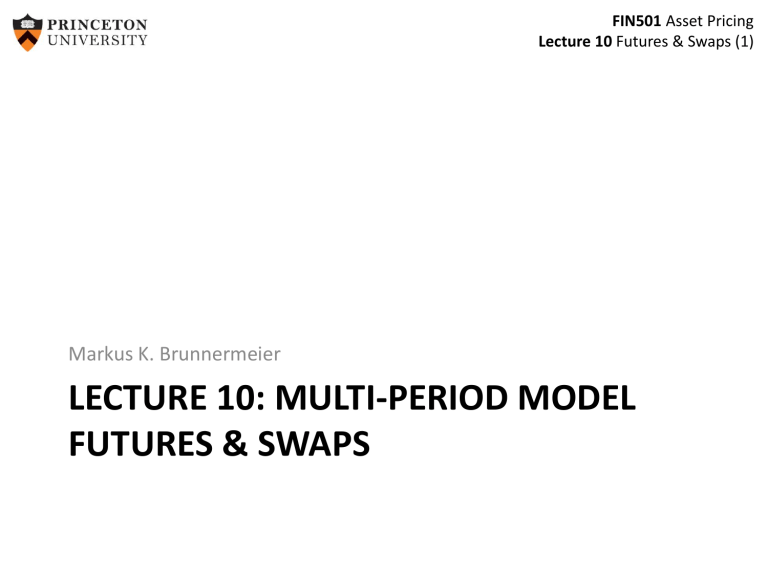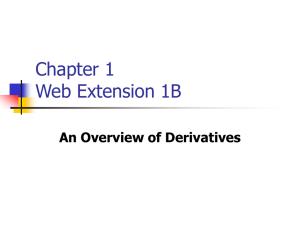
FIN501 Asset Pricing Lecture 10 Futures & Swaps (1) Markus K. Brunnermeier LECTURE 10: MULTI-PERIOD MODEL FUTURES & SWAPS FIN501 Asset Pricing Lecture 10 Futures & Swaps (2) Overview 1. Futures o o o o Forwards versus Futures Price Interest Rate Forwards and Futures Currency Futures Commodity Futures • Backwardation and Contango 2. Swaps FIN501 Asset Pricing Lecture 10 Futures & Swaps (3) Futures Contracts • Exchange-traded “forward contracts” • Typical features of futures contracts o Standardized, specified delivery dates, locations, procedures o A clearinghouse • Matches buy and sell orders • Keeps track of members’ obligations and payments • After matching the trades, becomes counterparty • Differences from forward contracts o Settled daily through mark-to-market process low credit risk o Highly liquid easier to offset an existing position o Highly standardized structure harder to customize FIN501 Asset Pricing Lecture 10 Futures & Swaps (4) Example: S&P 500 Futures (cont.) • • • • Notional value: $250 x Index Cash-settled contract Open interest: total number of buy/sell pairs Margin and mark-to-market o o o o Initial margin Maintenance margin (70-80% of initial margin) Margin call Daily mark-to-market • Futures prices vs. forward prices o The difference negligible especially for short-lived contracts o Can be significant for long-lived contracts and/or when interest rates are correlated with the price of the underlying asset FIN501 Asset Pricing Lecture 10 Futures & Swaps (5) Futures: Margin Balance • Mark-to-market proceeds and margin balance for 8 long futures: FIN501 Asset Pricing Lecture 10 Futures & Swaps (6) Forwards versus Futures Pricing • Price of Forward using EMM is 𝑄 0 = 𝐸𝑡 𝜌𝑇 𝐹0,𝑇 − 𝑆𝑇 𝑄 𝑄 = 𝐸𝑡 𝜌𝑇 𝐹0,𝑇 − 𝐸𝑡∗ 𝑆𝑇 − cov𝑡 𝜌𝑇 , 𝑆𝑇 Special case: 𝑄 𝐹0,𝑇 = 𝐸𝑡 𝑆𝑇 Homework: If I do it with 𝑀, then I get … • Value of Futures contract is always zero. Each period there is “dividend” stream 𝜙𝑡 − 𝜙𝑡−1 and 𝜙 𝑇 = 𝑆𝑇 𝑄 0 = 𝐸𝑇 [𝜌𝑡+1 𝜙𝑡+1 − 𝜙𝑡 ] for all t since 𝜌𝑡+1 is known at 𝑡 𝑄 𝜙𝑡 = 𝐸𝑡 𝜙𝑡+1 and 𝜙 𝑇 = 𝑆𝑇 𝑄 𝜙𝑡 = 𝐸𝑡 [𝑆𝑇 ] General: Futures price process is always a martingale FIN501 Asset Pricing Lecture 10 Futures & Swaps (8) Uses of Index Futures Delete??? • Why buy an index futures contract instead of synthesizing it using the stocks in the index? Lower transaction costs • Asset allocation: switching investments among asset classes • Example: Invested in the S&P 500 index and temporarily wish to temporarily invest in bonds instead of index. What to do? o Alternative #1: Sell all 500 stocks and invest in bonds o Alternative #2: Take a short forward position in S&P 500 index FIN501 Asset Pricing Lecture 10 Futures & Swaps (9) Uses of Index Futures (cont.) • $100 million portfolio with 𝛽 of 1.4 and 𝑟𝑓 = 6% 1. Adjust for difference in $ amount • 1 futures contract $250 x 1100 = $275,000 • Number of contracts needed $100mill/$0.275mill = 363.636 2. Adjust for difference in 𝛽 363.636 x 1.4 = 509.09 contracts FIN501 Asset Pricing Lecture 10 Futures & Swaps (11) Forward Rate Agreements • FRAs: over-the-counter contracts that guarantee a borrowing or lending rate on a given notional principal amount • Settlement: o In arrears: 𝑟𝑞𝑟𝑡𝑙𝑦 − 𝑟𝐹𝑅𝐴 × notional principal o At the time of borrowing: notional principal × • FRAs can be synthetically replicated with zero-coupon bonds 𝑟𝑞𝑟𝑡𝑙𝑦 −𝑟𝐹𝑅𝐴 1+𝑟𝑞𝑟𝑡𝑙𝑦 FIN501 Asset Pricing Lecture 10 Futures & Swaps (13) Eurodollar Futures • Contract specifications FIN501 Asset Pricing Lecture 10 Futures & Swaps (14) Eurodollar Futures • Very similar in nature to an FRA with subtle differences o The settlement structure of Eurodollar contracts favors borrowers o Therefore the rate implicit in Eurodollar futures is greater than the FRA rate ⇒ Convexity bias • The payoff at expiration: [Futures price - (100 - rLIBOR)] x 100 x $25 • Example: Hedging $100 million borrowing with Eurodollar futures: FIN501 Asset Pricing Lecture 10 Futures & Swaps (16) Treasury Bond/Note Futures • Contract specifications FIN501 Asset Pricing Lecture 10 Futures & Swaps (17) Treasury Bond/Note Futures (cont.) • Long T-note futures position is an obligation to buy a 6% bond with maturity between 6.5 and 10 years to maturity • The short party is able to choose from various maturities and coupons: the “cheapest-to-deliver” bond • In exchange for the delivery the long pays the short the “invoice price.” Price of the bond if it were to yield 6% Invoice price = (Futures price x conversion factor) + accrued interest FIN501 Asset Pricing Lecture 10 Futures & Swaps (18) Currency Contracts • Currency prepaid forward o Suppose you want to purchase ¥1 one year from today using $s 𝑃 o 𝐹0,𝑇 = 𝑥0 𝑒 −𝑟𝑦 𝑇 (price of prepaid forward) • where x0 is current ($/ ¥) exchange rate, and ry is the yendenominated interest rate • Why? By deferring delivery of the currency one loses interest income from bonds denominated in that currency • Currency forward o 𝐹0,𝑇 = 𝑥0 𝑒 𝑟−𝑟𝑦 𝑇 • 𝑟 is the $-denominated domestic interest rate • 𝐹0,𝑇 > 𝑥0 if 𝑟 > 𝑟𝑦 (domestic risk-free rate exceeds foreign risk-free rate) FIN501 Asset Pricing Lecture 10 Futures & Swaps (19) Currency Contracts: Pricing (cont.) • Synthetic currency forward: borrowing in one currency and lending in another creates the same cash flow as a forward contract • Covered interest arbitrage: offset the synthetic forward position with an actual forward contract FIN501 Asset Pricing Lecture 10 Futures & Swaps (20) Interest Rate Parity – FX Carry Trade • Covered Interest Rate Parity o Forward/futures hedged with offsetting currency portfolio • Uncovered Interest Rate Parity o Carry trade: • buy high interest rate currency and • sell short interest rate currency (funding currency) • And hope exchange rate does move against you o Carry trade with forward/futures (unhedged) FIN501 Asset Pricing Lecture 10 Futures & Swaps (21) Skewness of FX Carry Trade Returns • Up the stairs and down the elevator • Brunnermeier, Pedersen & Nagel (2012) FIN501 Asset Pricing Lecture 10 Futures & Swaps (22) Commodity Forwards • Commodity forward prices can be described by the same formula as that for financial forward prices: 𝐹0,𝑇 = 𝑆0 𝑒 𝑟−𝛿 𝑇 o For financial assets: 𝛿 is dividend yield o For commodities: 𝛿 is commodity lease rate • rate is return an investor makes from buying and lending out the commodity. • Can be backed out from forward prices FIN501 Asset Pricing Lecture 10 Futures & Swaps (23) Commodity Forwards • Forward curve (or the forward strip): Set of prices for different expiration dates for a given commodity o upward-sloping, then the market is in contango. o downward sloping, the market is in backwardation. o Note that forward curves can have portions in backwardation and portions in contango. FIN501 Asset Pricing Lecture 10 Futures & Swaps (24) Overview 1. Futures o o o o Forwards versus Futures Price Interest Rate Forwards and Futures Currency Futures Commodity Futures • Backwardation and Contango 2. Swaps o Commodity Swaps o Interest Rate Swaps FIN501 Asset Pricing Lecture 10 Futures & Swaps (25) Introduction to Swaps • Swap: contract calling for an exchange of payments, on one or more dates, determined by the difference in two prices. • means to hedge a stream of risky payments. • A single-payment swap is the same thing as a cash-settled forward contract. FIN501 Asset Pricing Lecture 10 Futures & Swaps (26) Example of a Commodity Swap • An industrial producer, IP Inc., needs to buy 100,000 barrels of oil 1 year from today and 2 years from today. • The forward prices for deliver in 1 year and 2 years are $20 and $21/barrel. • The 1- and 2-year zero-coupon bond yields are 6% and 6.5%. FIN501 Asset Pricing Lecture 10 Futures & Swaps (27) Example of Commodity Swap • IP wants to guarantee the cost of oil for the next 2 years • Enter long forward contracts for 100,000 barrels in each of the next 2 years. • The PV of this cost per barrel is $20 $21 + = $37.383 2 1.06 1.065 • Thus, IP could pay an oil supplier $37.383, and the supplier would commit to delivering one barrel in each of the next two years. • notional amount of the swap, e.g. 100,000 barrels determines the magnitude of the payments when the swap is settled financially • A prepaid swap is a single payment today for multiple deliveries of oil in the future. (multiple prepaid forwards) FIN501 Asset Pricing Lecture 10 Futures & Swaps (28) Example of Commodity Swap • With a prepaid swap, the buyer might worry about the resulting credit risk. Therefore, a better solution is to defer payments until the oil is delivered, while still fixing the total price. 𝑥 𝑥 + = $37.383 1.06 1.065 • Any payment stream with a PV of $37.383 is acceptable. Typically, a swap will call for equal payments in each year. o For example, the payment per year per barrel, 𝑥, will have to be $20.483 to satisfy the following equation: • We then say that the 2-year swap price is $20.483. FIN501 Asset Pricing Lecture 10 Futures & Swaps (30) Economics of Swaps • Swap o Multiple forward contracts (futures if exchange traded) o Implicit borrowing/lending arrangement • Example o Swap price of $20.483/barrel. Relative to the forward curve price of $20 in 1 year and $21 in 2 years, we overpay by $0.483 in 𝑡 = 1, and we underpay by $0.517 in 𝑡 = 2. o Lending the counterparty from 𝑡 = 1 to 𝑡 = 2o arranged at 𝑡 = 0. The interest rate on this loan is 0.517 / 0.483 – 1 = 7%. o Has to be consistent with implied forward rate in bond prices: 1- and 2-year zero-coupon bond yields of 6% and 6.5% FIN501 Asset Pricing Lecture 10 Futures & Swaps (31) Swap Counterparty skip • The situation where the dealer matches the buyer and seller is called a back-to-back transaction or “matched book” transaction. FIN501 Asset Pricing Lecture 10 Futures & Swaps (32) Market Value of a Swap • The market value of a swap is zero at inception. • Once the swap is struck, its market value will generally no longer be zero because: o forward prices for oil and interest rates will change over time; o even if prices do not change, the market value of swaps will change over time due to the implicit borrowing and lending. • Exit swap buy entering into an offsetting swap with the original counterparty or not • The market value of the swap is the difference in the PV of payments between the original and new swap rates. FIN501 Asset Pricing Lecture 10 Futures & Swaps (33) Interest Rate Swaps • Two arms: Fixed and floating arm • Notional principle of the swap is the amount on which the interest payments are based. • Swap term or swap tenor: life of swap • Settlement: o If swap payments are made at the end of the period (when interest is due), the swap is said to be settled in arrears. FIN501 Asset Pricing Lecture 10 Futures & Swaps (34) An example of an interest rate swap • XYZ has $200M of floating-rate debt at LIBOR • prefers fixed-rate debt with 3 years to maturity. • XYZ could enter a swap, in which they o receive a floating rate and o pay the fixed rate, which is 𝑅 = 6.9548%. FIN501 Asset Pricing Lecture 10 Futures & Swaps (35) Swap Payoffs • Counterparties swap fixed for floating ∝ notational 𝑁 • Fixed leg = fixed payment + 𝑁 at maturity, value falls with 𝑖 • Floating leg = floating payment + 𝑁 at maturity, value = 𝑁 FIN501 Asset Pricing Lecture 10 Futures & Swaps (36) Example of Interest Rate Swap On net, XYZ pays 6.9548%: XYZ net payment = – LIBOR + LIBOR – 6.9548% = –6.9548% Floating Payment Swap Payment FIN501 Asset Pricing Lecture 10 Futures & Swaps (37) Concentrated Holding of Interest Rate Swaps Bergenau et al. 2013 FIN501 Asset Pricing Lecture 10 Futures & Swaps (38) Swap ate • Relative asset pricing of swap rate 𝑅 o relative to forward rates implied by bond prices o 𝑟0 𝑡𝑖−1 , 𝑡𝑖 : implied forward interest rate from date 𝑡𝑖−1 to date 𝑡𝑖 , known at date 0, is. o 𝑞 0, 𝑡𝑖 : Price of zero-coupon bond maturing on 𝑡𝑖 o 𝑅 The fixed swap rate is. o n swap settlements, occurring on dates 𝑡𝑖 , 𝑖 = 1, … , 𝑛 FIN501 Asset Pricing Lecture 10 Futures & Swaps (39) Swap Rate • The requirement that the hedged swap have zero net PV is 𝑛 𝑍 0, 𝑡𝑖 𝑅 − 𝑟0 𝑡𝑖−1 , 𝑡𝑖 =0 𝑖=1 • Hence, 𝑅= 𝑛 𝑖=1 𝑍 0, 𝑡𝑖 𝑟0 𝑡𝑖−1 , 𝑡𝑖 𝑛 𝑖=1 𝑍 0, 𝑡𝑖 o where 𝑛𝑖=1 𝑍 0, 𝑡𝑖 𝑟0 𝑡𝑖−1 , 𝑡𝑖 is PV of interest payments implied by the strip of forward rates, and o 𝑛𝑖=1 𝑍 0, 𝑡𝑖 is the PV of a $1 annuity when interest rates vary over time. FIN501 Asset Pricing Lecture 10 Futures & Swaps (40) Swap Rate • Rewrite – to easy interpretation: 𝑛 𝑍 0, 𝑡𝑖 𝑅= 𝑟 𝑡 , 𝑡 0 𝑖−1 𝑖 𝑛 𝑗=1 𝑍 0, 𝑡𝑗 𝑖=1 • weighted average of the implied forward o zero-coupon bond prices determines weights FIN501 Asset Pricing Lecture 10 Futures & Swaps (41) Swap Rate • Third way of writing 1 − 𝑍 0, 𝑡𝑛 𝑅= 𝑛 𝑖=1 𝑍 0, 𝑡𝑖 1 - using 𝑟0 𝑡1 , 𝑡2 = 𝑍𝑍 0,𝑡 −1 0,𝑡2 This equation is equivalent to the formula for the coupon on a par coupon bond. Thus, the swap rate is the coupon rate on a par coupon bond. (firm that swaps floating for fixed ends up with economic equivalent of a fixedrate bond) FIN501 Asset Pricing Lecture 10 Futures & Swaps (42) Swap Curve • swap curve: Set of swap rates at different maturities • consistent with the interest rate curve implied by the Eurodollar futures o Recall Eurodollar futures contract provides a set of 3-month forward LIBOR rates. In turn, zero-coupon bond prices can be constructed from implied forward rates. Therefore, we can use this information to compute swap rates. FIN501 Asset Pricing Lecture 10 Futures & Swaps (43) Swap Curve For example, the December swap rate can be computed using equation (8.3): (1 – 0.9485)/ (0.9830 + 0.9658 + 0.9485) = 1.778%. Multiplying 1.778% by 4 to annualize the rate gives the December swap rate of 7.109%. FIN501 Asset Pricing Lecture 10 Futures & Swaps (44) Swap Curve • Swap spread is the difference between swap rates and Treasury-bond yields for comparable maturities. FIN501 Asset Pricing Lecture 10 Futures & Swaps (45) Swap’s Implicit Loan Balance • Implicit borrowing and lending in a swap can be illustrated using the following graph, where the 10-year swap rate is 7.4667%: FIN501 Asset Pricing Lecture 10 Futures & Swaps (46) Swap’s Implicit Loan Balance • In the above graph, o investor who pays fixed and receives floating. o in the early years: he pays a high rate of the swap, and hence lends money. o In the later years: Eurodollar forward rate exceeds the swap rate and the loan balance declines, falling to zero by the end of the swap. o Therefore, the credit risk in this swap is borne, at least initially, by the fixed-rate payer, who is lending to the fixed-rate recipient. FIN501 Asset Pricing Lecture 10 Futures & Swaps (47) Why Swap Interest Rates? • Interest rate swaps permit firms to separate credit risk and interest rate risk. o By swapping its interest rate exposure, a firm can pay the short-term interest rate it desires, while the long-term bondholders will continue to bear the credit risk. FIN501 Asset Pricing Lecture 10 Futures & Swaps (48) LIBOR OIS Spread FIN501 Asset Pricing Lecture 10 Futures & Swaps (49) Deferred Swap • A deferred swap is a swap that begins at some date in the future, but its swap rate is agreed upon today. • The fixed rate on a deferred swap beginning in k periods is computed as 𝑇 𝑖=𝑘 𝑍 0, 𝑡𝑖 𝑟0 𝑡𝑖−1 , 𝑡𝑖 𝑅= 𝑇 𝑖=𝑘 𝑍 0, 𝑡𝑖 FIN501 Asset Pricing Lecture 10 Futures & Swaps (50) Amortizing and Accreting Swaps • An amortizing swap is a swap where the notional value is declining over time (e.g., floating rate mortgage). • An accreting swap is a swap where the notional value is growing over time. • The fixed swap rate is still a weighted average of implied forward rates, but now the weights also involve changing notional principle, Qt: 𝑅= 𝑛 𝑖=1 𝑄𝑡𝑖 𝑍 0, 𝑡𝑖 𝑛 𝑖=1 𝑄𝑡𝑖 𝑍 𝑟 𝑡𝑖−1 , 𝑡𝑖 0, 𝑡𝑖 (8.7) FIN501 Asset Pricing Lecture 10 Futures & Swaps (51) Overview 1. Futures o o o o Forwards versus Futures Price Interest Rate Forwards and Futures Currency Futures Commodity Futures • Backwardation and Contango 2. Swaps o Commodity Swaps o Interest Rate Swaps



